37: Loonie's Court - a distraction
Compiled by Charlie Hulme
Davenport Station home | Index to History pages
This page is something of a distraction from our Davenport theme, but is something I've been interested in for a while. I hope you find it interesting.

Why is there a street in Stockport, leading from John Street to Norbury Street, called 'Loonies Court'? An insignificant car parking area, with no houses, its south end is opposite a location that many Stockport residents will have visited at some time, the entrance to Stockport's Registry Office for Births, Marriages and Deaths, part of the Town Hall complex.
Recently, it has been designated as part of a safe cycling route from Stockport station to the town centre, presumably increasing the number of people passing that way.
The nameplate at the upper end has often been missing, perhaps having become a decoration on someone's wall, or maybe it is prone to being hit by cars. There is no sign at the lower end, but it does still officially exist as a street.
It seems a very odd sort of name, with its mental health connotations. Indeed, a booklet called Stockport Streets: What's in a Name features it on the cover, and proposes a derivation from the madness caused by the use of mercuric nitrate in the Stockport hatting industry. However, it's doubtful whether the Stockport authorities would sanction such a name.
But in December 2020 while looking in my archived Street Directories for something else, my eye lighted on the name 'Loonie, Alexander. Rock Cottage, Newbridge Lane' - immediately my thoughts turned to the mystery street name, and I made a mental note of it.
A couple of weeks later, however, I received an email from someone who had bought at auction the Victorian cast-iron original nameplate, and has gathered much information on the man and his family. He suggested that it might make a good article for the website. Despite being in the middle of writing another article, I distracted myself into further research, and this is the result.
I've also followed clues into some other aspects of Stockport history.
Alexander Loonie
So who was this Mr Loonie? He was born c. 1794 in Ireland, where surnames often have variable spellings, including Lonnie and Lunny (e,g the well known Irish musician Donal Lunny). At the time of writing the Chief Excutive of BP is Bernard Looney.
He was in England by 1820 when he married Elizabeth Pinnington, and in Stockport by 1830. At the time of the 1841 census his address was given as Newbridge Lane where the couple had a young servant, Jane Dodd. In 1850 the family house was on Wellington Road North, but they eventually settled in 'Rock Cottage' in Newbridge Lane, which seems to have been the long-lost house that stood on a rocky projection into the river (an auctioneer's business stands there in 2021.) They had a daughter, Eliza, born 1817, who married a Manchester Veterinary Surgeon, John Gibson Their son Alexander Loonie Gibson, went on to establish a veterinary surgery of his own in the Birmingham area.
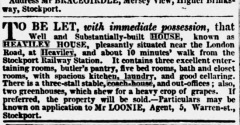
Alexander Loonie set up in business at 5 Warren Street, Stockport, describing himself in 1857 as 'auctioneer and in 1864 as 'general agent, auctioneer, valuer, house, land, and insurance agent'. He also seems to have acted as an accountant. Clearly he was in a strong position to invest in property. He probably also owned the terrace of three houses on Wellington Road South behind the three Loonie's Court houses.
The Railway Inn
Wellington Road South where the houses 89-93 (odd) stand, backing on to Loonie's Court, is part of the by-pass road created in the 182os when the area was still open fields. The new road attracted house-builders, and it was eventually lined with buildings, including many small houses, many of which were later converted to shops.
We haven't established a date for the erection of these buildings, but In the census of 1851, the houses appear, seen, with different numbers: 77, 79 and 81; later there was a renumbering, which was not uncommon at the time.
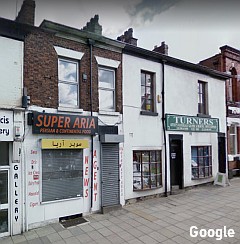
Picture from 2008.
Early in their life 77 and 79 (later 91 and 93) were merged to make one larger house which later became the 'Railway Inn', perhaps in the hope of attracting passengers from the station, whose access road is opposite.
The 1851 census shows the householder as Joseph Lang, cotton carder, but an 1857 directory lists John Cunliffe, beer retailer helped by his wife, daughter Hannah as barmaid, and her son Henry, a clerk.
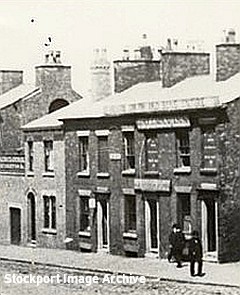
This picture shows the Inn in business, around 1880, by which time it was a 'tied house' of Daniel Clifton's brewery. No. 77 appears to be a shop.
The Inn, latterly a Wilsons' pub, closed sometime around 1970 (anyone know when?) and 88-91 became Turner's Art Shop, well known to many budding Stockport artists.
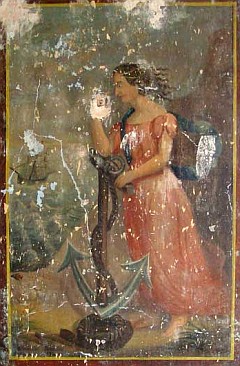
In 2010, the shop managers were redecorating an upstairs room after a water leak and found, under layers of distemper and wallpaper, a number of mural paintings, which a local historian declared to date from 1840.
(Stockport Library have a photograph, dated 1962, of one of the pictures. Nobody knows who painted them.)
The art shop later re-located to another building on the other side of the road. and has since closed. Other businesses have moved in to No.91, and there are now two flats above; the paintings have probably been covered.
Some job titles
Cotton weaver: could refer to any job in weaving 'sheds', but mostly the operations of the weaving looms. By 1850 factories powered looms were taking over cottoin weaving from the traditional hand-loom at home.
Overlooker: equivalent of Foreman - supervising a group of weavers.
Throstle doffer: in a cotton-spinning mill, removes bobbins of finished yarn and replaces them with new ones.
Reeler: in a spinning mill, operated the machine that winds the yarn on to the bobbin.
Cotton Piecer: in a spinning mill, pieces together broken threads.
Shuttle maker: the shuttle is the wooden device that passes back and forth between the threads in the weaving operation.
Heald sizer: also known as heald varnisher, Maintains the healds (or heddles) which move the warp threads of a loom to allow the shuttle carrying the weft thread to pass between.
Fur trimmer: a role in a hat factory preparing animal fur for processing into felt. Stockport was a centre of the hatting industry.
There's a long list of Victorian occupations here.
Thanks
Special thanks are due to Gerry Durham for inspiration and assistance with this feature, Janet Nicholson for permission to use images, and to the Stockport Memories Facebook Group.Sources
Penny Knight, Stockport Hatting. Stockport Council, 2000.Mike Ogden. A history of Stockport Breweries. Neil Richardson, 1987
'From Rabbit Fur to Bowler'. Illustrated London News, 10 July 1909, page 65.
Stockport Image Archive.
Old-maps.co.uk
British Newspaper Archive
Robert Collister's image collections, YouTube.co.uk
Journey into the Past: Railway Inn
by Janet Nicholson
Hidden Murals: Manchester Evening News 3 November 2010
(Some paper sources have been unavailable to us due to the 2021 'Lockdown'.)

A modern view of the area; what remains of Loonie's Court is the curving path between John Street and its disappearance under a building to emerge on Norbury Street. In the foreground is the bulk of the Town Hall staff car park, which has eradicated part of Lord Street and the site of the Sutton and Torkington Hat Works. There are no houses on Loonie's Court, but at one time there were houses in what is now the back-yard area of the buildings on Wellington Road.

I photographed this modern sign in 2008. The actual name of the street is Loonie's Court: Stockport follows the widely accepted convention of omitting apostrophes on street name signs. By August 2009 it had disappeared, apparently never to be replaced...

... but a visit in 2023 found a new sign in place, in the revised style with the coat-of-arms in black rather than blue and a letter 'U' which differs from the standard 'Kindersley' typeface.
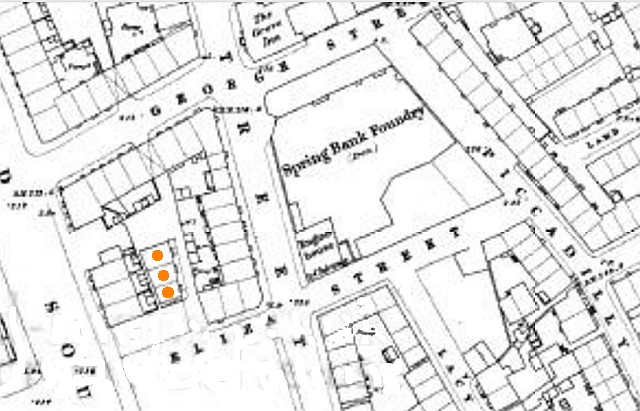
The plan above is enlarged from part of an Ordnance Survey map of Stockport dated 1851; I have marked the three houses, which I believe comprised Loonie's Court, in colour. George Street and Eliza Street were later re-named Norbury Street and John Street; as Stockport's borough boundaries expanded, notably to include the Heatons area north of the River Mersey, duplication of names arose, resolved by re-naming. The Spring Bank Foundry was later taken over as a hat works.
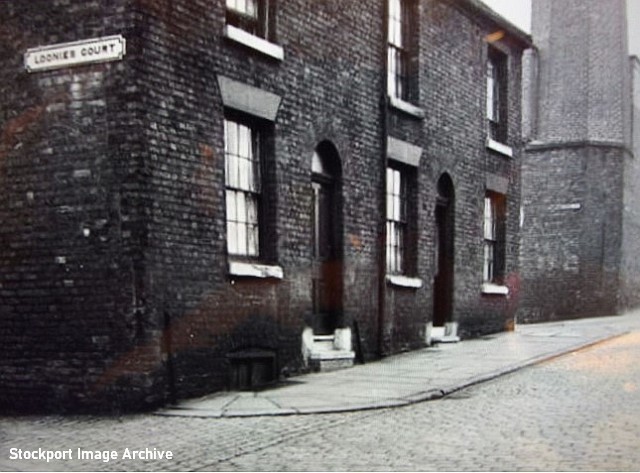
This picture was taken by H. Lees in 1960 on John Street (ex-Eliza Street); The chimney of the hat works looms behind. The houses are typical of the area; the far window belongs to 82 Lord Street round the corner. Note the 'donkey-stoned' front steps, found in every northern mill town.

Norbury Street (ex-George Street), 1960. The opening on the right (you can see why the Google camera car didn't pass through!) is the entrance to Loonie's Court, which survives with its building above in 2021, although all the other buildings have disappeared except the Grove Hotel on the left, which is no longer an inn.
So why Loonie's Court? To house the workers of Stockport's booming industry, homes were needed, and many of them were arranged in 'courts' - usually a courtyard with shared 'privies', surrounded by terraced houses, often with only one door each, facing the courtyard, a variation on the 'back-to-back' system found elsewhere. Often, access was through an arched passage. Many were named after people, presumably the investors who paid for their construction and receive the rent; in the area near Loonie's Court in the 1890 could be found Lee's, Taylor's, Brindley's, Eskrigge's, Beswick's, and Buckley's Courts plus several more. (Most old maps do not label them, except the 1895 1:1056 issue.) Some, including Loonie's, were not true 'courts' but the houses were of the same style. Many survived, in inceasingly poor condition, to be photographed just before demolition in the 'slum clearances' of the 1960s, although the Loonie's houses had a much shorter life. More recently the 'court' name has again become popular for housing developments and care homes, but very few, if any, of the originals survived the slum clearances of the 60s and 70s. One oddity, 'Joule's Court', off Waterloo Road, survives on the map as an industrial estate.
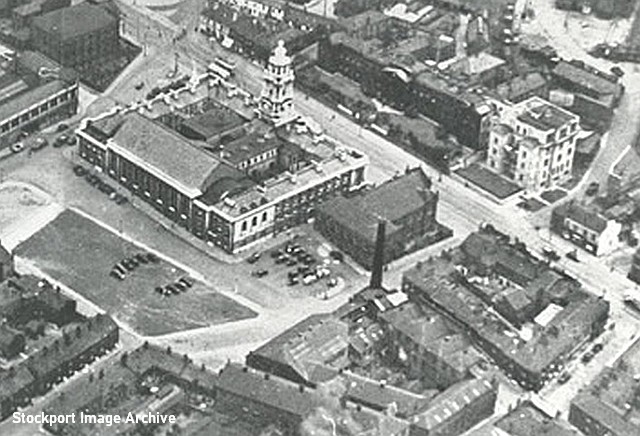
An over-enlarged section of an aerial view of the Town Hall dated 1949, long after the Loonie's Court houses had disappeared. The pathway Loonie's Court can be seen making its way diagonally inside the block of buildings to the right. The three original houses on Wellington Road remain, and the later-built Wellington Road house (no.87, formerly no. 75) has been extended at the rear. This building also at some time had a Loonie's Court backyard partner, but there's no clear record of its occupants.
The adjacent Sutton and Torkington hat works, with its tall engine house chimney, was still in operation at the time. In later years the chimney was truncated, as the factory would have converted to other power options.

Eskrigge's Court, 1960
Entering the word 'court' as a search term in the Stockport Image Archive reveals a large number of them, recorded before demolition, including the example above, Eskrigge's Court, not far from the site of Loonie's Court. The Ritz Cinema can be glimpsed on the left. The Loonie's houses may have resembled the 'half-house' seen end-on behind the un-inviting outside toilet block. The investor in this case was a member of the wealthy Eskrigge family who lived in the area; perhaps William Linton Eskrigge, partner in the Park Mill spinning mill, who lived in a large house, 'Spring Mount', in the Edgeley area of Stockport. He was Mayor of Stockport in 1864 and later an Alderman. The family is recorded in detail by Allan Russell on one of his 'Big Houses of the Heatons' articles.

This map is from 1897: The 'New Inn' (later renamed the Town Hall Tavern) has been built on the Eliza Street corner for Showell's Stockport Brewery, Broomfield Road. The factory has extended to the other side of Piccadilly, the buildings connnected by a bridge.
Who lived there?
In answering that question we have to leave behind the Commercial Travellers, Hat Manufacturers and Artists who are the usual cast in our Davenport features, and join the ranks of the weavers, piecers, reelers and throstle doffers of Stockport's textile industry. (see opposite for some job names.)
The three houses on Wellington Road are not mentioned in the 1851 census nor but the Loonie's Court houses, despite appearing on the 1851 map, cannot be found on the census. The first mention we have found is in 1861:
1861
1 Loonie's Court: Elizabeth Clydesdale (51) widow, cotton weaver; James Clydesdale (22) son, cotton weaver.
2 Loonie's Court: Thomas Kitchen (65) Cotton worker; Elizabeth Kitchen (52 wife); Jane Kitchen (31) cotton weaver; Elizabeth Ann Kitchen (6) granddaughter, scholar.
3 Loonie' s Court: Thomas Baxter (aged 35) Overlooker of cotton weaver;
Anna W Baxter (36) wife, cotton weaver; Samuel Baxter (15) son, errand boy; Emma Baxter (13) daughter, cotton weaver; James Baxter (11) son, scholar; Thomas Baxter (5) son, scholar; Catherine Baxter (10) daughter, scholar; Elizabeth Ann Baxter (16) niece, cotton weaver.
3 Loonie's Court (?): James Woodhall (63) silk weaver, Mary Woodhall (57) wife, laundress.
1871
1 Loonie's Court: Elizabeth Clydesdale (61) widow, cotton weaver; James Clydesdale (32) son, cotton weaver.
2 Loonie's Court: Joel Sutton (32) Police Officer; Isabella Sutton (37) wife born Staveley Derbyshire; Martha J Sutton (7) daughter born Manchester.
3 Loonie's Court: Thomas Clarke (40) coach driver; Hannah Clarke (40) wife; Walter Clarke (15) son, Cotton throstle doffer; Thomas Clarke (14) son, Tinplate works apprentice; James Clark (10) son, Cotton throstle doffer; Martha A Clark (8) daughter, scholar; William B Clark (6), son, scholar; Ann Clark (4) daughter, scholar; Mary B Clark (6 months) daughter.
1881
1 Loonie's Court: Emma Hulse (54) widow, Laundress; Tom Hulse (26) son, unemployed hairdresser; George Henry Hulse (15) Throstle doffer; Sarah Hulse (13) daughter, Lasher-on, hat shop.
2 Loonie's Court: Nancy Knowles (55) widow, Housekeeper; Frances Knowles (3) Granddaughter; James Tipping (32) boarder, shuttle maker
3 Loonie's Court: unoccupied.
1891
1 Loonie's Court: unoccupied.
2 Loonie's Court: Ernest Eckersley Rhodes (36) Heald sizer; Alice (36) wife, dressmaker; Henry Rhodes (14) son, fur trimmer; Sydney Rhodes (10) son, scholar; Lily Rhodes (5) scholar; Margaret Rhodes (3) daughter.
3 Loonie's Court: Mary Ann Lowe, 63, widow; Annie Lowe (34) son, Cotton Piecer. Harry Lowe. 22 Cotton reeler.
The 1901 census lists all three as unoccupied, and an 1907 map no longer shows the houses. The 1911 census lists only a stable in Loonie's Court. Removing the houses would have made the houses on Wellington Road meet the requirements of the by-laws of the time which required an open backyard space to be provided behind a dwelling. The state of housing provision in the area as more people were attracted to factory work is revealed on the 1851 census of nearby Lord Street, where most of the houses recorded a second household in a 'cellar dwelling.'
Sutton and Torkington
The block to the east of Loonie's court, across Lord Street. was for many years occupied the Sutton and Torkington Ltd Felt Hat Manufactory, It's history is not covered in any detail in Penny Knight's book Stockport Hatting, and there are connections with the Cale Green area, so we'll mention here what can be found about its story.
As the 1851 map above shows, the buildings on the site were previously an iron works, the Spring Bank Foundry, operated by John Robinson, born 1799 in Tatham, Lancashire; the 1851 lists him at 17 Upper Brook Street, Stockport, with his wife, children, two apprentices and a general servant. He is described as an Ironfounder and Ironmonger. John Robinson died in 1859, and the factory was offered in an auction in 1860.
Thomas Peacock Torkington was the son of the late Mr. and Mrs. William Torkington, of Cale Green, Stockport, and like his father William, he worked at the Cale Green hat works of S.R. Carrington, until 1871 when Thomas and his brother-in-law Thomas Lees Sutton (born 1843) left to form their own business, which began, according to Sutton's 1871 record, employing '6 men, 4 women, 2 girls, 1 boy'). At some stage, they moved in to Spring Bank Works, and gradually extended into more of the premises, resulting in a very cramped site.
The firm became a limited company in 1896, with family members as directors, and by 1909 employed over 600 workers. The two founders used the resulting wealth to move into large villas on the Buxton Road, the southern continuation of Wellington Road. Torkington and his family moved from their modest house in Cale Green to 'Needwood', 177 Buxton Road, and Sutton moved his family from a small house at 224 Shaw Heath to 'Highfield', no. 167 Buxton Road. Unlike no. 177 which has been lost for modern development, 'Highfield' (not to be confused with several other houses of the same name) survives intact in 2021, completely hidden by trees from passers-by, and with new-build flats in the back garden. Mr Torkington died in 1903, while Thomas Sutton died in 1923 after a long illness.
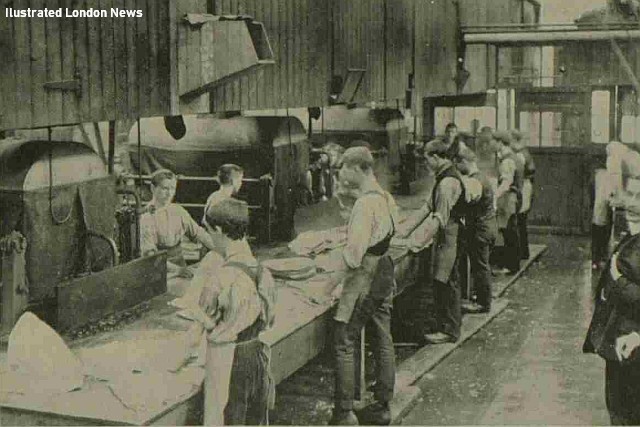
'Planking' - consolodating and shrinking the felt. Spring Bank works, 1909.
The firm, with its London showroom at 26 Fore Street, E.C., flourished flourished until in the mid-twentieth century men's fashion moved away from felt hat-wearing. In 1955 the Carrington works at Cale Green was closed and its operations moved into the Spring Bank works, but in 1964 production ended. The buildings were demolished and replaced by new offices and car parking for Stockport Council.
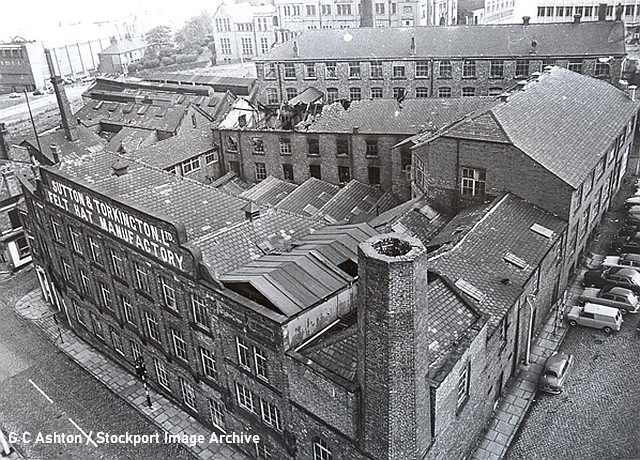
The factory after a fire in 1962.
Lord Street (a part which no longer exists) is in the bottom left corner of the above image. John Street, formerly Eliza Street, to the right. The bridge over Piccadilly can be seen behind the damaged area.
See other features: Cale Green Park for more about Carrington's Hat works and A Tram on the A6 for more about large houses on the A6.
Complied by Charlie Hulme, February 2021. Updated June 2023
Comments are very welcome at charlie@davenportstation.org.uk